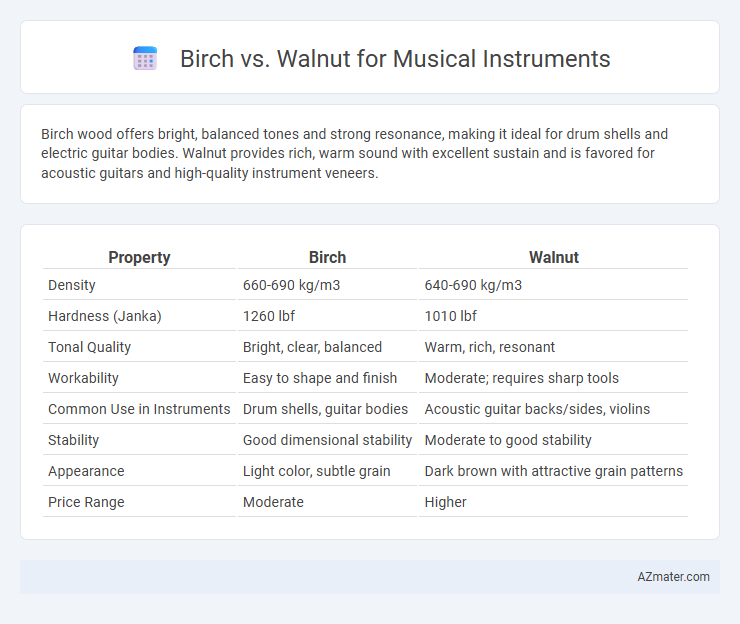Birch wood offers bright, balanced tones and strong resonance, making it ideal for drum shells and electric guitar bodies. Walnut provides rich, warm sound with excellent sustain and is favored for acoustic guitars and high-quality instrument veneers.
Table of Comparison
| Property | Birch | Walnut |
|---|---|---|
| Density | 660-690 kg/m3 | 640-690 kg/m3 |
| Hardness (Janka) | 1260 lbf | 1010 lbf |
| Tonal Quality | Bright, clear, balanced | Warm, rich, resonant |
| Workability | Easy to shape and finish | Moderate; requires sharp tools |
| Common Use in Instruments | Drum shells, guitar bodies | Acoustic guitar backs/sides, violins |
| Stability | Good dimensional stability | Moderate to good stability |
| Appearance | Light color, subtle grain | Dark brown with attractive grain patterns |
| Price Range | Moderate | Higher |
Overview of Birch and Walnut Woods
Birch wood, prized for its fine, even grain and bright tonal qualities, offers strong midrange resonance and a balanced sound, making it popular for drum shells and acoustic instrument bodies. Walnut wood features a rich, warm tone with pronounced low frequencies and a visually striking grain pattern, favored in guitar backs and fingerboards for its durability and aesthetic appeal. Both woods provide distinct acoustic benefits and visual characteristics that influence instrument sound and playability.
Physical Properties Comparison
Birch wood is known for its bright tone and dense, fine grain, making it ideal for producing clear, articulate sounds with strong projection in musical instruments. Walnut features a medium density and rich grain patterns, offering a warmer, more balanced tonal quality with good sustain. Both woods provide durability, but birch tends to be harder and more impact-resistant, whereas walnut offers slightly better resonance and aesthetic appeal in instrument crafting.
Acoustic Characteristics
Birch wood offers bright, clear tonal qualities with strong midrange projection, making it ideal for instruments requiring punchy and articulate acoustic performance. Walnut provides a warmer, richer sound with balanced mid and low frequencies, enhancing resonance and sustain in musical instruments. Musicians often choose birch for its clarity in amplified settings, while walnut suits acoustic instruments emphasizing warmth and depth.
Durability and Longevity
Birch offers high durability with its dense grain structure, making it resistant to dents and scratches, which helps maintain the instrument's integrity over time. Walnut, while slightly softer, provides excellent longevity due to its natural stability and resistance to warping under varying humidity conditions. Both woods are favored for their balance of robustness and tonal quality, but birch generally excels in environments requiring greater impact resistance.
Tone Quality in Musical Instruments
Birch offers a bright, focused tone with strong midrange presence, making it ideal for drums and electric guitars that require clear attack and projection. Walnut provides a warmer, richer sound with balanced lows and sparkling highs, favored in acoustic instruments for its natural resonance and complex harmonics. Both woods exhibit excellent sustain and durability, but birch emphasizes clarity while walnut enhances tonal depth.
Workability and Crafting Differences
Birch offers excellent workability with its fine, even grain, making it easier to carve and shape for detailed musical instrument components, while walnut's dense, oily texture requires sharper tools and more effort but yields a rich, warm tone ideal for guitars and violins. Birch produces bright, clear sound resonance, favored in drum shells and acoustic instrument parts, contrasting with walnut's superior sustain and midrange warmth, preferred in high-quality fretboards and bodies. Crafting with birch allows faster turnaround due to its predictable machining, whereas walnut demands skilled craftsmanship to prevent chipping and maximize its aesthetic grain patterns.
Aesthetic Appeal and Grain Patterns
Birch wood features a pale, creamy color with subtle, fine grain patterns that provide a smooth and consistent surface ideal for a sleek, modern look on musical instruments. Walnut boasts rich, dark brown hues with striking, swirling grain patterns that enhance the visual depth and luxury, often favored for high-end guitars and woodwinds. The choice between birch and walnut significantly impacts the instrument's aesthetic character, with birch offering light elegance and walnut delivering bold, dramatic appeal.
Cost and Availability
Birch offers a more cost-effective option for musical instruments, generally priced lower than walnut due to its widespread availability and faster growth rate. Walnut, prized for its rich tonal qualities and aesthetic appeal, commands higher prices and can be less readily available because of slower growth and limited regional sources. Musicians and manufacturers often balance budget constraints with tonal preferences when choosing between birch's affordability and walnut's premium characteristics.
Popular Instrument Applications
Birch wood is favored for drum shells due to its bright, punchy tone and strong projection, making it a staple in snares and toms, while walnut is prized in guitar bodies and fingerboards for its rich, warm sound and striking grain patterns. Birch's density provides excellent durability and resonance, enhancing drums' attack and sustain, whereas walnut offers a balanced tonal response, ideal for acoustic and electric stringed instruments. Both woods are chosen for their distinct tonal qualities and aesthetic appeal, influencing popular music genres and instrument craftsmanship.
Choosing the Right Wood for Your Sound
Birch produces a bright, clear tone with strong midrange presence, ideal for drums and electric guitars requiring projection and attack. Walnut offers a warmer, richer sound with balanced low and high frequencies, favored for acoustic guitars and string instruments needing deeper resonance. Selecting birch emphasizes articulation and punch, while walnut enhances warmth and tonal complexity, crucial factors in defining your instrument's sound profile.

Infographic: Birch vs Walnut for Musical Instrument
 azmater.com
azmater.com